5 Top Retail Email Marketing Trends for 2023


There is no denying that email marketing was a key channel for retailers trading through the pandemic in 2020. In 2021 and 2023, email took on a new level of importance, as email reclaims the top spot in revenue and dependancy. And with retail brands using email more frequently to build customer relationships, competition is fierce. Brands must continually optimise their approach to stay ahead of the game and get subscribers’ attention. We've outlined some top trends for email marketers in retail this year.
In The Direct Marketing Association’s 2018 email tracking study, it was revealed that email marketing receives on average 40x ROI and 95% of respondents rated the channel as ‘important’ or ‘very important’ to their business. That number has not changed much in the last decade, but we are now seeing email budgets increase and more focus appearing on the channel.
Here are 5 top email marketing trends for retailers to improve email marketing ROI in 2021.
1. Show up with email marketing everywhere in the customer lifecycle
Email marketing is a fab acquisition channel, but it's really important to factor all of the other potential touchpoints. Here's how we look at the customer lifecycle for retail:
- Acquisition (finding new subscribers and nurturing them)
- Consideration (getting subscribers to consider your product/brand)
- Experience (helping newly found customers - this is where retention begins)
- Loyalty & Retention (getting customers to repeat purchase)
- Win-back & Reactivation (getting lapsed customers and prospects to come back)
As a guide, you should be aiming towards 30-50 automated email campaigns in a retail brand.
2. Personalisation and segmentation
Because email campaigns are becoming more data-driven, there’s now a need for more relevant and personalised email marketing. We should expect personalisation and segmentation strategies to continue growing in sophistication.
According to eMarketer, 78% of retail consumers are more likely to become repeat customers if they’re sent targeted personal offers. Also, emails with personalisation have a 29% higher open rate and 41% higher click through rate (Experian).
Brands are now using firmographic, behavioral, demographic and psychographic data to deliver personalised marketing content to subscribers.
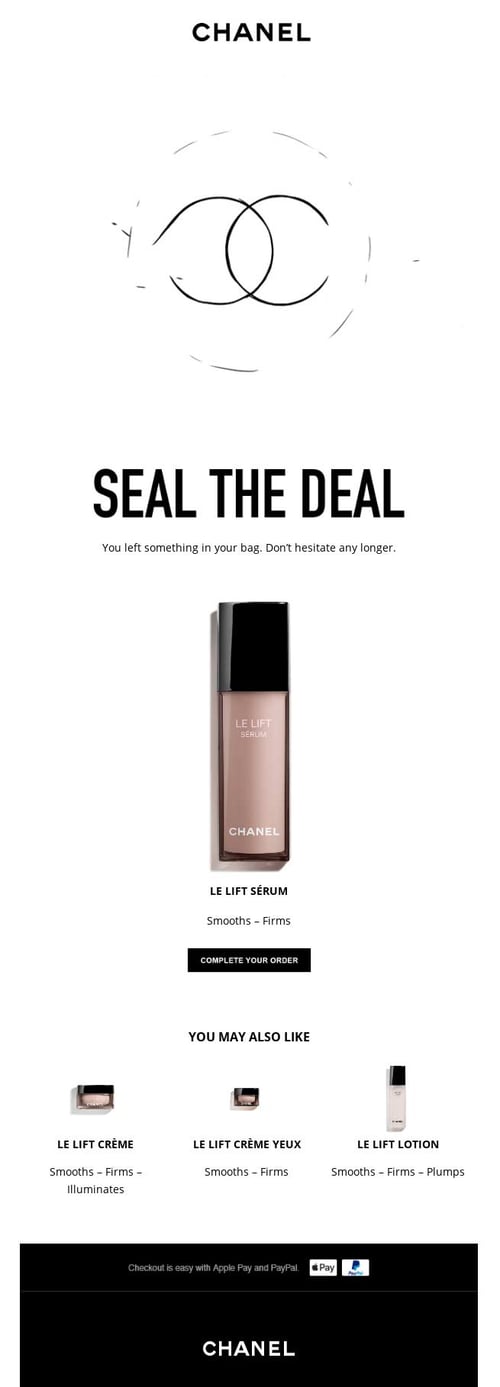
In this email, Chanel try to get the subscriber to come back and check out by showing not just the product that they carted, but the related products. Brands could take this further, by using AI to determine what products people are most likely to be interested alongside those that they carted and show those in the secondary block.
Behavioural personalisation is a great way to win back lapsed customers or even encourage customers to convert on abandoned baskets. The best part about integrating behavioural data in your email marketing campaigns is that it’s based on the customer’s very last action, meaning it will always be relevant to them.
3. Relevance and context
Relevancy involves getting the right email messages in front of subscribers at the right times. If your brand can do this, then you’re more likely to achieve your clicks and conversion potential.
It goes without saying that data is still king. Using data to provide relevant and timely emails is still the main ingredient of a successful email marketing program. With this relevancy and context, your brand will deliver stronger and more timely emails - this is what truly gets results.
But don't stop there. Testing your email campaign volume and frequency will help you to create even more impact.
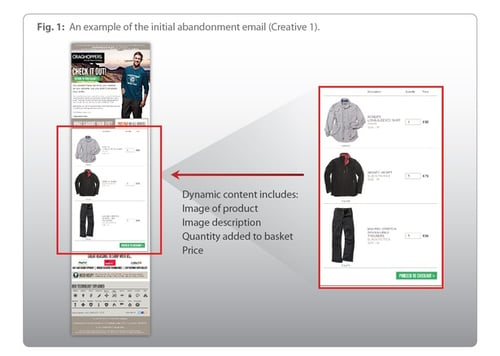
In this email, Craghoppers achieved impressive results through a basket abandonment campaign. Emails were sent to customers 24 hours and three days after cart abandonment - just enough time for them to reconsider making a purchase.
4. AI and virtual assistants
Artificial Intelligence and machine learning is growing among email marketers. Now that there are easier and more affordable ways to access cloud resources, all kinds of businesses are able to work with data sets. This information can then be used to contribute to an improved user experience.
For example, platforms offered by companies such as Phrasee and Persado use machine learning to learn what resonates best with a specific marketer’s audience. These email tools allows marketers to determine what subject lines or calls-to-action (CTAs) recipients are most likely to respond to. According to Phrasee, its AI-generated subject lines outperform human-written subject lines 95% of the time!
Nykaa.com used Boomtrain, an AI-powered marketing engine, to deliver more personalised and relevant experience to their subscribers through email marketing. Here are a few highly-targeted campaigns they ran on particular segments:
- The first email targets the segment “users who bought L’Oreal products”.
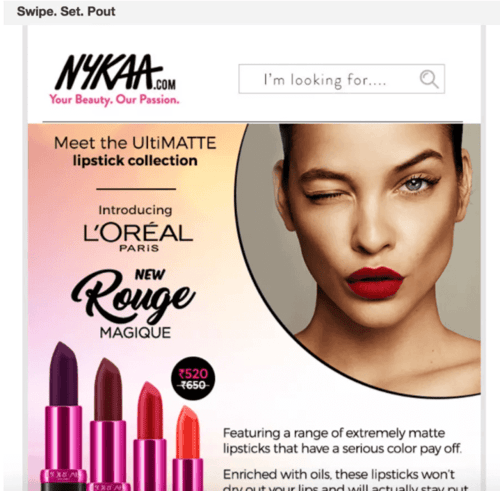
- The second email targets “highly engaged users” via an information campaign, including details about different beauty products.
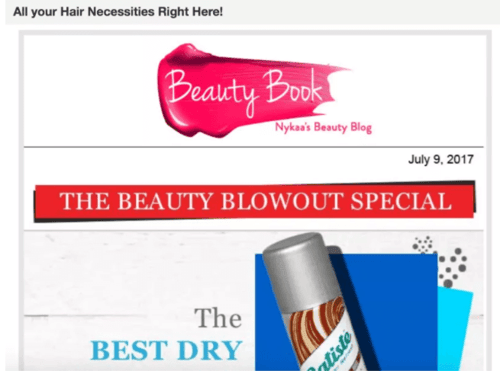
- Finally, they target “users who bought hair products” and are also “highly engaged” with this third email.
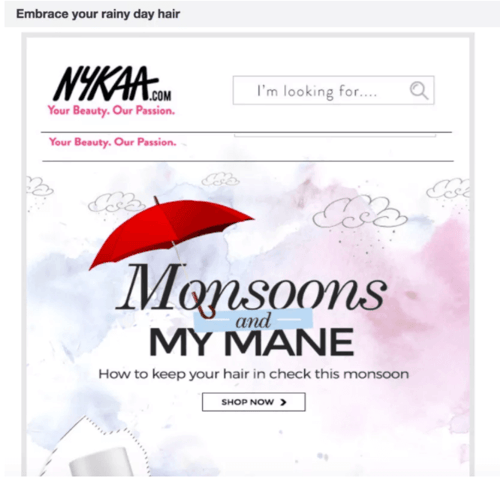
5. Email marketing automation
In the 2017 Adestra email marketing report, two-thirds of marketers chose marketing automation capability as the most important part of their email service provider’s technology platform.
Automating emails will save your brand time and you won’t have to manually compose every message you’re sending. Your brand can also make smarter decisions with automation using third-party software. For example, reacting to trigger events and sending different messages based on these events.
Automation also ties in closely with the trend of segmentation and personalisation of emails. According to Krzysztof Jarecki of ExpertSender: “Most companies have a large content library, so we’ll see greater automation of segmentation and matching of customers with the most appropriate content for their business goals.”
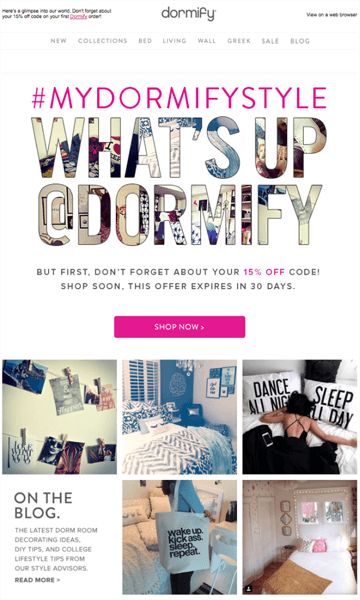
In this email campaign, the lifestyle brand Dormify adopted an automated email series in place of their batch-and-blast system.
By segmenting and tending to the different needs of its customers, Dormify was able to set up an automated email campaign. This allowed email marketers to deliver relevancy through a personalised automated email series: welcome emails, cart abandonment campaigns and post-purchase marketing.
Summary: Keep up with the competition
For the best ROI, your brand needs to remain on top of the trends and retain a competitive edge. Many of the techniques mentioned are not new, but they’ve become increasingly popular as they help move customers through the customer lifecycle. Whether it’s harnessing user data, embracing a third-party app or delivering more relevancy, there are lots of opportunities for retail brands to grow their email marketing program.
Suggested Reading From The Blog
Most Popular Blogs
20 Horrifyingly Good Halloween Email Creative Examples
4 Minute Read
20 Great Birthday Email Marketing Examples
5 Minute Read
Top 10 Email Marketing Platforms for 2024
6 Minute Read
Editor's Picks
Top 10 CDPs for Email Marketing in 2024
4 Minute Read
Top 10 Email Marketing Platforms for 2024
6 Minute Read
20 Black Friday Countdown Email Marketing Examples
4 Minute Read
